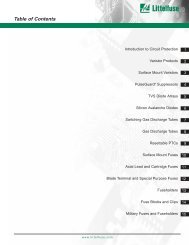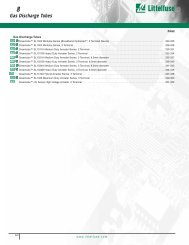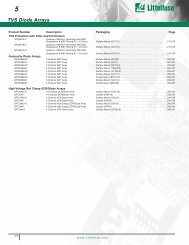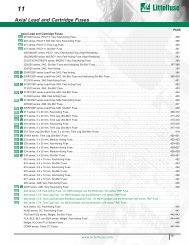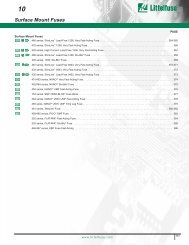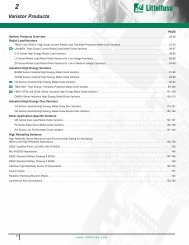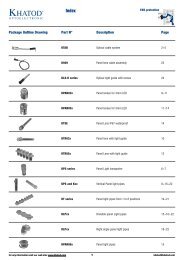ALUMINUM ELECTROLYTIC CAPACITORS
ALUMINUM ELECTROLYTIC CAPACITORS
ALUMINUM ELECTROLYTIC CAPACITORS
Create successful ePaper yourself
Turn your PDF publications into a flip-book with our unique Google optimized e-Paper software.
SURFACE MOUNT <strong>ALUMINUM</strong> <strong>ELECTROLYTIC</strong> <strong>CAPACITORS</strong> Surface Mount<br />
RECOMMENDED REFLOW SOLDERING CONDITIONS<br />
Alchip TM -MVS/MVA/MV/MVE/MVK/MKA/MZA/MVY/MZE/MZD/MLA/MVJ/MLE/MLD/MVL/<br />
MVH/MHB/MKB/MV-BP/MVK-BP<br />
Temp (C)<br />
The following conditions are recommended for air convection and infrared refl ow soldering on the SMD products on to a glass epoxy<br />
circuit boards by cream solder. The dimensions of the glass epoxy boards with resist are 90B50B0.8mm for B55 to KG5 case code SMD<br />
capacitors and 180B90B0.8mm for LH0 to MN0 case codes SMD capacitors.<br />
The temperatures shown are the surface temperature values on the top of the can and on the capacitor terminals.<br />
Refl ow should be performed twice or less.<br />
Please ensure that the capacitor became cold enough to the room temperature (5 to 35C) before the second refl ow.<br />
Consult with us when performing refl ow profi le in IPC / JEDEC (J-STD-020)<br />
@Recommended soldering heat conditions (Except for Conductive Polymer Aluminum Solid Capacitors)<br />
Peak<br />
230<br />
217<br />
Peak temp.<br />
Preheat<br />
Time (sec.)<br />
Max. period of time over 230C<br />
Max. period of time over 217C<br />
@Recommended Solder Land on PC Board<br />
Series : MVS/MVA/MV/MVE/MVK/MKA/MZA/MVY/MZE/MZD/MLA<br />
MVJ/MLE/MLD/MVL/MVH/MHB/MKB/MV-BP/MVK-BP<br />
b<br />
a<br />
b<br />
c<br />
Location of capacitor<br />
?PRECAUTIONS FOR USERS<br />
: Solder land on PC board<br />
Soldering method<br />
The capacitors of Alchip-series have no capability to with stand such dip<br />
or wave sol der ing as totally immerses components into a solder bath.<br />
Refl ow soldering<br />
Refl ow the capacitors within recommended refl ow soldering con di tions.<br />
Verify there is no temperature stress to the capacitors because the fol low -<br />
ing dif fer enc es might degrade capacitors electrically and mechanically.<br />
Please con sult us if other refl ow conditions are employed.<br />
1.Location of components : Temperature increases at the edge of PC<br />
board more than the center.<br />
2.Population of PC board : The lower the component population is, the<br />
more temperature rises.<br />
3.Material of PC board : A ceramic made board needs more heat than a<br />
glass epoxy made board. The heat increase may cause damage to the<br />
capacitors.<br />
4.Thickness of PC board : A thicker board needs more heat than a thinner<br />
board. The heat increase may damage the capacitors.<br />
5.Size of PC board : A larger board needs more heat than a smaller<br />
board. The heat increase may damage the capacitors.<br />
6.Solder thickness<br />
If very thin cream solder paste is to be used for SMD types, please<br />
consult with us.<br />
7.Location of infrared ray lamps : IR refl ow as well as hot plate refl ow<br />
heats only on the reverse side of the PC board to lessen heat stress to<br />
the capacitors.<br />
Contents<br />
Lead-free type (high heat durability design) Original type<br />
SMD type Case code<br />
Voltage<br />
range<br />
(Vdc)<br />
Use Supplement Code "G" for case code B55 to JA0,<br />
Supplement Code "N"<br />
and "S" for case code KE0 to MN0<br />
Time maintained Time maintained<br />
Preheat Peak temp. Reflow number Preheat<br />
Time maintained<br />
Peak temp.<br />
above 217c above 230c<br />
above 200c<br />
B55 to F90<br />
4 to 50V<br />
63 to 80V<br />
90sec. max 60sec. max. 260Cmax. 2 times or less<br />
60sec. max. 40sec. max. 250Cmax. 2 times or less<br />
240Cmax.<br />
-<br />
4 to 50V<br />
60sec. max. 30sec. max. 245Cmax. 2 times or less<br />
230Cmax.<br />
H63 to JA0<br />
Vertical<br />
63 to 100, 150 to 180C<br />
150Cmax.<br />
400V<br />
30sec. max. 20sec. max. 240Cmax. 2 times or less<br />
20sec. max. 230/ 240Cmax.<br />
120sec. max.<br />
120sec. max.<br />
6.3 to 50V<br />
30sec. max. 20sec. max. 240Cmax. 2 times or less<br />
KE0 to MN0<br />
230Cmax.<br />
63 to 450V<br />
20sec. - 230Cmax. 2 times or less<br />
D46, E46, F46 4 to 50V<br />
40sec. max. 30sec. max. 250Cmax. 2 times or less -<br />
(2/2)<br />
Case code<br />
B55<br />
D46, D55, D60, D61, D73<br />
E46, E55, E60, E61, E73<br />
F46, F55, F60, F61, F73, F80, F90<br />
H63<br />
HA0<br />
JA0<br />
KE0, KG5<br />
LH0, LN0<br />
MH0, MN0<br />
Terminal code : A Terminal code : G<br />
a<br />
0.8<br />
1.0<br />
1.4<br />
1.9<br />
2.3<br />
3.1<br />
4.5<br />
4.0<br />
6.0<br />
6.0<br />
b<br />
2.2<br />
2.6<br />
3.0<br />
3.5<br />
4.5<br />
4.2<br />
4.4<br />
5.7<br />
6.9<br />
7.9<br />
c<br />
1.6<br />
1.6<br />
1.6<br />
1.6<br />
1.6<br />
2.2<br />
2.2<br />
2.5<br />
2.5<br />
2.5<br />
a<br />
3.1<br />
4.5<br />
3.4<br />
4.7<br />
4.7<br />
CAT. No. E1001H<br />
b<br />
4.2<br />
4.4<br />
6.3<br />
7.8<br />
8.8<br />
c<br />
3.5<br />
3.5<br />
9.3<br />
9.6<br />
9.6<br />
Rework of soldering<br />
Use a soldering iron for rework. Do not exceed an iron tip temperature of<br />
380P10C and an exposure time of 3P0.5 seconds.<br />
Mechanical stress<br />
Do not use the capacitors for lifting the PC board and give stress to the<br />
ca pac i tor. Avoid bending the PC board. This may damage the ca pac i tors.<br />
Cleaning assembly board<br />
Immediately after solvent cleaning, remove residual solvent with an air<br />
knife for at least 10 minutes. If the solvent is insuffi ciently dry, the capacitors<br />
may corrode.<br />
Coating on assembly board<br />
1.Before curing coating material, remove the cleaning solvents from the<br />
assembly board.<br />
2.Before conformal coating, a chloride free pre-coat material is rec om -<br />
mend ed to decrease the stress on the capacitors.<br />
Molding with resin<br />
Internal chemical reaction gradually produces gas in the capacitor; then,<br />
increasing internal pressure. If the end seal of the capacitor is com plete ly<br />
coverd by resin the gas will be unable to escape causing a potentially<br />
dangerous situation. The chlorine contained resin will penetrate into the<br />
end seal, reach the inside element, and cause damage of the capacitor.<br />
Others<br />
Refer to Precautions for Users of Aluminum Electrolytic Capacitors.




